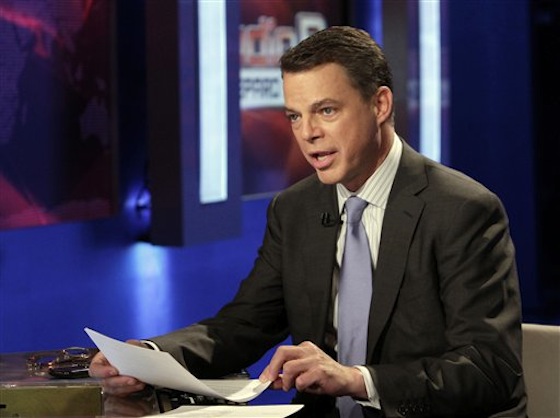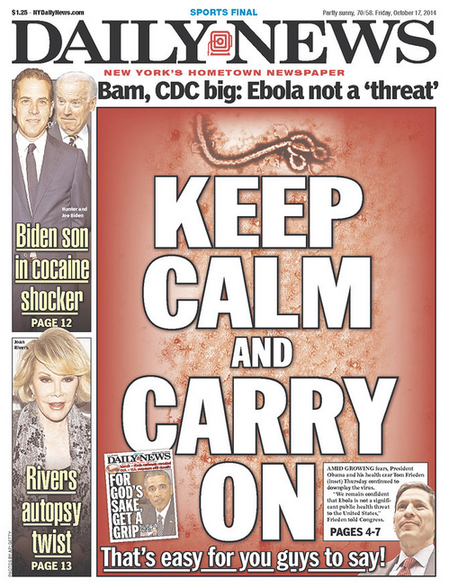Sign up for The Media Today, CJR’s daily newsletter.

Shep Fox News’ Shepard Smith is among the most prominent journalists to speak out against a fear-inducing Ebola media narrative
On October 10, two days after Thomas Eric Duncan became the first person to die from Ebola on US soil, news directors of Gannett TV stations discussed on a conference call how to stop the spread of a contagion. The actual virus had killed only one person here, but judging from Gannett viewer feedback across the country, media hysteria — a different sort of pathogen — had already begun to infect Americans. So the news directors collectively decided to insert some balance back into the discussion.
The TV stations partnered Thursday with Gannett newspapers, including USA Today, in publishing in-depth Ebola explainers on their websites, with interactive maps of the virus’ origins, breakdowns of its symptoms and spread, and what readers can do to help stop it. Live-chats on air or online gave audiences direct access to experts. Gannett journalists nationwide, meanwhile, promoted the discussion on Twitter with a unified hashtag, #FactsNotFear.
“We believe, just as the medical profession has a duty to stop the spread of Ebola, we as journalists — and especially as local journalists — have a responsibility to stop the spread of fear and panic,” said Ellen Crooke, vice president of news at Gannett Broadcasting.
The media’s sense of urgency on Ebola in America was already crescendoing when Duncan died on October 8. And since then, amid endless speculation on cable programs, paranoid headlines in print and online tabloids, and the echo chamber that is Twitter, the hysteria has intensified without much context. Indeed, nearly two-thirds of Americans now fear a widespread epidemic, according to a Washington Post-ABC News poll, and that’s despite previous attempts to stem the tide of fear-inducing coverage — CBS News and The Guardian respectively debunked virus myths on October 6 and October 9, for example.
In the middle of this week, however, something appeared to change: Many journalists began countering the narrative that had taken shape, injecting perspective into coverage where it had been sorely lacking just days before.
 No national organization took an institutional stand similar to Gannett’s, though the more restrained storylines were on full display by Wednesday. “Ebola isn’t spreading across the United States, but anxiety about the virus certainly is,” a CNN.com report declared. A Washington Post Web headline the same day read, “An epidemic of fear and anxiety hits Americans amid Ebola outbreak.” The Post’s David Ignatius, The New York Daily News’ Denis Hamill, New York Times’ Frank Bruni, and New Yorker’s Michael Specter all panned the growing state of panic in columns. USA Today explained how cultural disconnects and language barriers have only helped fears spread. Even the Daily News, which had previously trumpeted Ebola fears on its front page, changed direction Friday in print.
No national organization took an institutional stand similar to Gannett’s, though the more restrained storylines were on full display by Wednesday. “Ebola isn’t spreading across the United States, but anxiety about the virus certainly is,” a CNN.com report declared. A Washington Post Web headline the same day read, “An epidemic of fear and anxiety hits Americans amid Ebola outbreak.” The Post’s David Ignatius, The New York Daily News’ Denis Hamill, New York Times’ Frank Bruni, and New Yorker’s Michael Specter all panned the growing state of panic in columns. USA Today explained how cultural disconnects and language barriers have only helped fears spread. Even the Daily News, which had previously trumpeted Ebola fears on its front page, changed direction Friday in print.
“So far, emergency rooms have not been overwhelmed with people afraid that they have caught the Ebola virus, and no one is hiding in the basement and hoarding food,” The Times’ Benedict Carey reported Wednesday. “But there is little doubt that the events of the past week have left the public increasingly worried.”
Before the recent spate of factcheck coverage, much media output on Ebola suggested that people should worry. CNN’s Legal View posed the question of whether Ebola is “the ISIS of biological agents.” Fox and Friends told viewers that it’s “primed” to go airborne. MSNBC Morning Joe host Joe Scarborough has repeatedly voiced his personal concerns about the virus, arguing on Meet the Press that the government is misleading the public about it. Numerous other segments likewise sounded the alarm.
“It’s a domino effect,” said Larry Rosen, a psychology professor at California State University, Dominguez Hills. “As soon as there is a crisis, people want to watch the news. Most people have several stations that they watch. So stations have to intensify what they broadcast and distill it to the most dramatic thing that they can say.”
Such drama only intensifies once politics becomes part of the equation, said Karen Dill-Shackleford, director of the media psychology program at Fielding Graduate University. Politicians and partisan commentators alike have used the virus to take shots at the Obama administration — or to deflect them. On Wednesday night, for example, Fox News host Sean Hannity asked Karl Rove, the political strategist, not only how Ebola would play in the midterm elections, but also how to best treat the virus.
Ebola is surely a compelling story, not to mention a legitimate crisis in West Africa that has claimed thousands of lives. But as Fox News’ Shepard Smith admirably told his American viewers on Wednesday, “I report to you with certainty this afternoon that being afraid is the wrong thing to do. Being petrified — and that’s a quote — is ridiculous.”
“Best advice for you and your family at this moment: get a flu shot,” he continued. “Unlike Ebola, flu is easily transmitted. Flu, along with resulting pneumonia, killed 52,000 Americans last year alone.”
As Smith concluded his remarks, the latest news of the Ebola-infected healthcare worker continued scrolling across the red bar at the bottom of the screen.
Has America ever needed a media defender more than now? Help us by joining CJR today.


